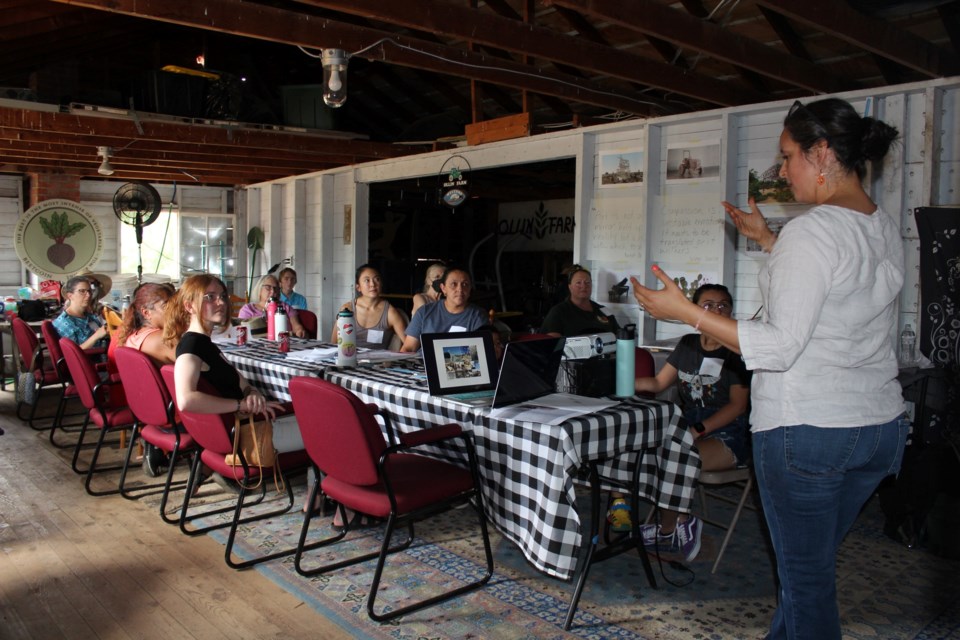In a workroom tucked in the corner of the Longmont Museum, sounds of clay slapping the table and amiable chatter fill the room.
Members of the Longmont community were asked to participate in an art project that artist Margarita Cabrera designed for the agri+ CULTURE exhibit created by the Longmont Museum and Boulder Museum of Contemporary Art or BMoCA.
Cabrera defines herself as a social practices artist, meaning she works collaboratively on art projects with members of the community to get a holistic view of social issues.
“So different from painters, photographers and sculptors, which I mean we work in sculpture, but the difference is that we are working with communities to address social issues and engaging with groups of people as part of the process,” Cabrera said.
Jared Thompson, curator of agri+CULTURE, explained that for this exhibition artists were paired with farmers, so the artists could learn more about farming in Colorado, but also feel more connected to the land.
“We want to celebrate the area's agriculture history, it’s really strong in this area, but we also want to just help people realize their connections to the land and explore that,” Thompson said.
For the exhibition, the Longmont Museum and BMoCA have paired 15 artists with 15 farms, both community based and commercial.
Thompson explained that they chose Cabrera not only because her artwork was beautiful, but also because she was a community artist who could bring the community’s voice into the museum.
“So we want to bring community members' voices into the galleries. We want them to be heard, we want them to know it is their museum, they belong here. We don't want to do a top down approach, we want them to help them create what we show in the galleries,” Thompson said.
There will be agri+ CULTURE exhibits at Longmont Museum, BMoCA and three farms starting in the summer of 2023. The farms displaying exhibits include Agricultural Heritage Center, the Milk and Honey Farm and Ollin Farm.
Cabrera was paired with Ollin Farm because her cousin, Kena Guttridge, is the owner.
Ollin Farm is a family owned, nutrient dense farm that prioritizes the health of their soil. It does not use any pesticides on their plants.
“What makes us different from other farms is we care about the organisms that live in the soil, if they are healthy the plant is healthy. Bugs don’t attack healthy soil, so we don’t use pesticides. Then you provide that to the community,” Guttridge said.
Ollin Farm has been serving the Longmont community for 15 years, and they believe a farm is not just about growing food, but connecting to the community. This led Guttridge and her husband, Mark, to participate in the agri+ CULTURE exhibition.
“Farming is in art. It’s an art of creating and planting, so I think everything is related to art,” Guttridge said.
Guttridge also hopes this exhibition will bring a focus on local farming because the harvests sizes have decreased this year from 60 harvests to 50 harvests, which Guttridge believes to be a significant decrease.
“I think we are in a crucial time and we need to support the farmers directly. They really need to understand the value of local farming, and create a consciousness of support and community building,” Guttridge said.
The first part of this project was for participants to go to Ollin Farm where they learned how they grow food. Then each participant shared a personal story related to food accessibility or growing food themselves, and translated that story onto a clay pot that they sculpted in workshops on Wednesday, Friday and Saturday.
The stories and pots were asked to be focused around three themes: pollination, food accessibility and soil regeneration.
“All of these are representing the stories of all these wonderful local citizens and individuals who are interpreting their connection to the land and to the environment, and their stories are inspiring,” Cabrera said.
Cabrera envisions all of these clay pots to be attached to a pole with a spoon on the end. The spoon is symbolic of an old parable where in Hell the spoons were too long to be used by one individual, but they were perfect for feeding someone else. Once those in Hell realized they could feed each other, they were sent to Heaven.
Next summer, Cabrera plans to use these spoons at a feast. She wants to demonstrate the power of working together and listening to one another through both the art and the usage of the spoon itself.
“We will be organizing a large feast and using the spoons to feed each other. So people will have to be very careful and aware and communicate like ‘hey is this okay,’ ‘what do you need.’So it's like an example of how we need to be with each other in a community. We need to be stewards, caring for each other and being kind,” Cabrera said.
Through this project Cabrera is able to connect more deeply with the community and appreciates that all of the partners, including the participants, the artists, farmers and curators, are all engaged in the process allowing for a holistic view of the community.
“It’s not always easy because we are dealing with diverse perspectives and addressing issues from these diverse perspectives and histories. We all think differently and a project like this allows all of our diversity to come together to give a more wholesome truth to a particular issue. It’s about looking to our diversity as a strength, not a weakness that divides us,” Cabrera said.



